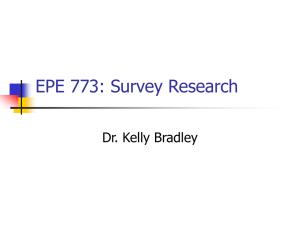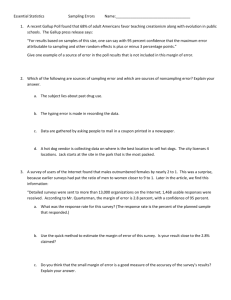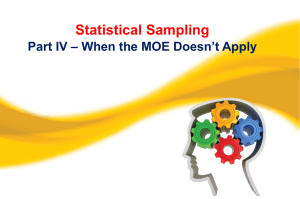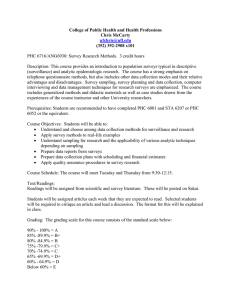BACKGROUND ON THE SURVEY PROCESS
advertisement
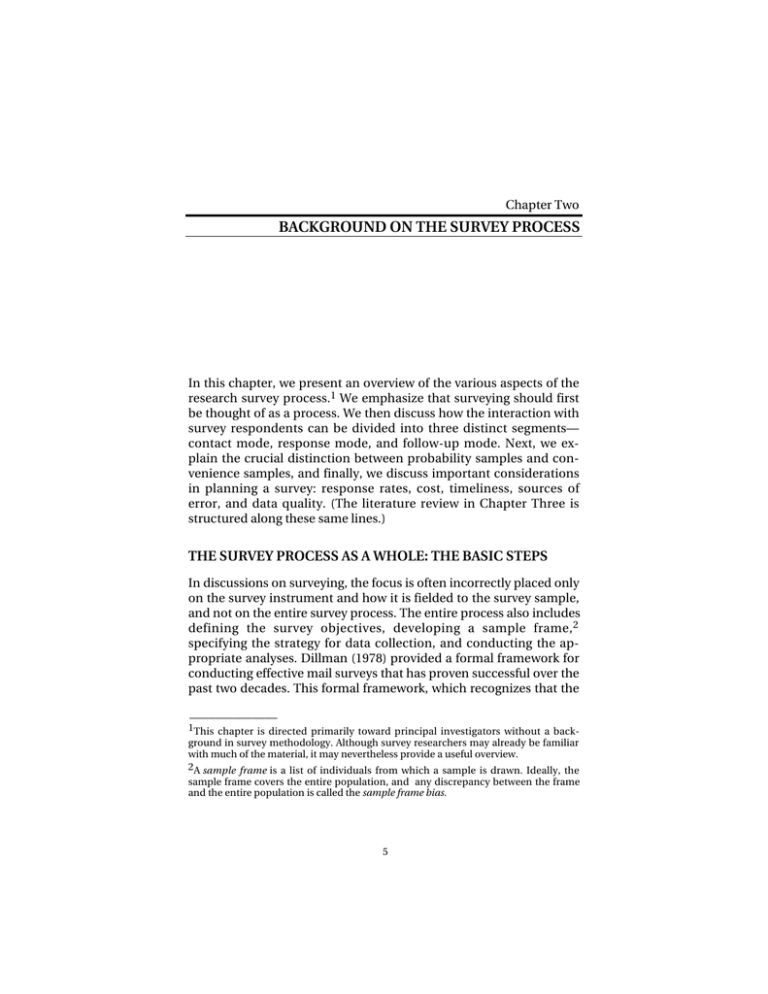
Chapter Two BACKGROUND ON THE SURVEY PROCESS In this chapter, we present an overview of the various aspects of the research survey process.1 We emphasize that surveying should first be thought of as a process. We then discuss how the interaction with survey respondents can be divided into three distinct segments— contact mode, response mode, and follow-up mode. Next, we explain the crucial distinction between probability samples and convenience samples, and finally, we discuss important considerations in planning a survey: response rates, cost, timeliness, sources of error, and data quality. (The literature review in Chapter Three is structured along these same lines.) THE SURVEY PROCESS AS A WHOLE: THE BASIC STEPS In discussions on surveying, the focus is often incorrectly placed only on the survey instrument and how it is fielded to the survey sample, and not on the entire survey process. The entire process also includes defining the survey objectives, developing a sample frame, 2 specifying the strategy for data collection, and conducting the appropriate analyses. Dillman (1978) provided a formal framework for conducting effective mail surveys that has proven successful over the past two decades. This formal framework, which recognizes that the ______________ 1 This chapter is directed primarily toward principal investigators without a background in survey methodology. Although survey researchers may already be familiar with much of the material, it may nevertheless provide a useful overview. 2A sample frame is a list of individuals from which a sample is drawn. Ideally, the sample frame covers the entire population, and any discrepancy between the frame and the entire population is called the sample frame bias. 5 6 Conducting Research Surveys via E-Mail and the Web entire process of fielding a survey is important to achieving acceptable response rates, ultimately resulted in the widespread acceptance of mail surveys as a respected research methodology. The basic tenet of the Total (or Tailored) Design Method (TDM) (Dillman, 1978 and 2000) and Total Survey Design (TSD) (Fowler, 1993) is that the entire survey process is critical to success. Essentially, TDM and TSD suggest that a researcher should take a holistic approach to survey design by consciously considering all aspects of the survey process. In particular, TDM emphasizes that the survey process is part of a social interaction between the researcher and the survey respondent and stresses the importance of appropriately communicating the survey to the respondent. TSD recognizes the trade-offs that must be made between methodological rigor in the various components of the survey process and the attendant costs, with an eye to developing a survey that meets the needs of the research study while recognizing the survey’s constraints. Some texts, such as Groves (1989), center on structuring the entire survey design process in order to balance total measurement error with cost. Although a formal survey-process framework is as yet undefined for Internet surveys, the basic steps in the process should be the same as with any other survey medium: 1. Defining the survey objectives, including • specifying the population of interest • delineating the type of data to be collected • determining the desired precision of the results. 2. Determining who will be sampled, including • specifying the method of sample selection as either – probability-based or – convenience-based3 ______________ 3 In a probability sample, the probability with which an individual is selected into a sample can be computed. When the probability cannot be computed, the sample is Background on the Survey Process • creating a sampling frame (if necessary) • selecting the sample. 7 3. Creating and testing the instrument, including • choosing the response mode (mail, Web, or other) • drafting the questions • pretesting and revising the survey instrument. 4. Contacting respondents throughout the survey process by using the following: • prenotification that the survey is coming • postdelivery reminder and thank-you • nonresponse follow-up for those who do not return the survey. 5. Data collection, data reduction, and analysis. CONTACT, RESPONSE, AND FOLLOW-UP MODES Interaction with survey respondents can be divided into three main components: contact, response, and follow-up. Each of these three components can be conducted in a different mode, that is, by telephone, mail, Web, or e-mail. For example, respondents may be contacted by U.S. mail to participate in a Web survey and the follow-up for nonrespondents may be conducted in yet another mode. This sort of categorization is not found in the traditional literature because not very many different combinations can be formed with the two most commonly used traditional survey modes: mail and telephone. However, we have found this classification to be important in categorizing and describing the various ways the Internet can be used in the survey process, and it proved useful in our compiling an evidence table of the literature (see Appendix B). called a convenience sample (it is more “convenient” to not have to worry about the ability to compute probabilities of selection). 8 Conducting Research Surveys via E-Mail and the Web Response modes can also be grouped according to whether they are interviewer-administered or self-administered; in-person and telephone surveys fall into the former category whereas mail and Internet surveys fall into the latter. Responses can also be collected using a single mode or via mixed modes in which respondents may initially be given a choice of response media or the type of media is sequenced as potential respondents are contacted repeatedly. PROBABILITY AND CONVENIENCE SAMPLES Survey sampling can be grouped into the following two broad categories: probability-based sampling (also loosely known as random sampling)4 and convenience sampling. In this report, we concentrate much of our discussion on probability-based surveying because the probability selection mechanism allows for valid statistical inference about an entire population, which is often the focus of research surveys. As stated earlier, a sample is considered a probability sample when the probability with which every person was selected into the sample is known. The sampling probabilities for each person are not necessarily equal. Oftentimes, the population can be enumerated in some fashion. This enumeration results in a list or some other mechanism from which individuals are selected. This enumeration may be an actual one (for example, a complete list of the population) or it may be implied (such as with a multistage sampling scheme in which only the members of selected primary sampling units are actually enumerated). Because probability samples are relatively expensive, probability-based surveys stand to benefit the most from less-costly survey alternatives becoming available through Internet-based surveying. With a convenience sample, the probability by which every respondent was included in the sample cannot be determined. Generating convenience samples typically requires much less time and effort than generating probability samples, and thus usually involves less ______________ 4Some researchers use the term “random sampling” to describe only those samples that have equal probability of being selected. In this report, we employ the morecolloquial usage of the term random sampling. Background on the Survey Process 9 cost, but convenience samples generally do not support statistical inference. Nevertheless, convenience sampling can be useful to researchers in a number of ways. For example, responses from a convenience sample might be useful in developing hypotheses early in the course of research, identifying various issues surrounding the research subject, defining response categories for multiple-response questions, or collecting other sorts of noninferential data. In fact, in certain types of qualitative research, convenience samples generated from the Web may be just as valid as convenience samples that are generated using other modes. Also, the advent of more-sophisticated statistical techniques, most notably propensity scoring5 (Rosenbaum and Rubin, 1983 and 1984), may allow some types of inference from convenience samples. We do not discuss survey sampling any further in this report, but details on survey sampling can be found in Kish (1965), Cochran (1977), and Henry (1990). In Chapter Four, we discuss various types of Internet surveys that arise from the distinction between probability and convenience samples. IMPORTANT CONSIDERATIONS IN PLANNING A SURVEY In this section, we point out the major considerations that drive the choice of mode or modes employed in the survey design process— particularly in a research survey. Later, we compare and contrast conventional and Internet-based alternatives.6 Response Rates When methodological statements are made about surveys, it is the response rate that is often mentioned first. Response rates are measured relative to the size of the sampling frame and therefore are only as good as the sample frame itself. Any discrepancy between the sampling frame and the target population is referred to as coverage ______________ 5Propensity scoring is a technique that can be used to reduce the bias that arises when individuals are not probabilistically selected into a sample (so-called self-selection bias). 6For comprehensive texts on planning and conducting surveys, see Fowler (1993), Groves (1989), or Dillman (2000). 10 Conducting Research Surveys via E-Mail and the Web error. (This subject is covered in more detail later in the section “Sources of Error.”) Because there are no sampling frames for convenience samples, response rates for those samples are not meaningful. It may be interesting to report response rates when they can be computed, but they cannot be interpreted in the same way that response rates for probability samples are interpreted. For the traditional response modes—including telephone, mail, and in-person—de Leeuw (1992) studied how survey mode affects responses, both in terms of response rates and biases. She classified mode factors into three categories: (1) media related (the visual presentation, for example); (2) information-transmission related (the telephone lines, for example); and (3) factors that affect the impact the interviewer has on the respondent. She found little difference among interviewer-assisted modes (in-person or telephone interviews) in terms of data quality (such as for item or unit nonresponse).7 When comparing interviewer-assisted modes with mail, de Leeuw found that interviewer-assisted modes result in higher response rates and lower item nonresponse, but also tended to bias the answers toward ones that are more socially acceptable (de Leeuw, 1992, p. 118). That is, mail surveys were found to have higher item and unit nonresponse rates, but when questions were answered, the responses were of better quality, particularly for sensitive questions. Cost Designing a survey requires making trade-offs between the quality and quantity of data and the cost to obtain that data. Here, we provide a general comparison of costs for various survey alternatives, holding all other survey dimensions constant. One component of total survey cost that is sometimes overlooked is the researchers’ time for survey design and subsequent data analysis. This can be a major cost component depending on the size of the survey. However, the costs for design and data analysis vary little by ______________ 7Item nonresponse occurs when a respondent chooses not to respond to an individual question. Unit nonresponse occurs when a member of the sample does not participate in any part of the survey. Background on the Survey Process 11 contact, response, or follow-up mode. One major expense that does vary by mode is the labor cost for personnel who actually execute the survey. Depending on the size of the survey and the complexity of its design, researcher labor costs or survey personnel labor costs, or a combination of the two, may end up being a significant portion of the survey budget. Interviewer labor costs tend to make face-to-face surveys the most expensive to conduct, followed by telephone interview surveys. Mail surveys eliminate interviewer labor by substituting it with the less labor-intensive activities of assembling survey mail packages and coding the responses when they are returned. Consider a survey that takes a respondent one-half hour to complete. For a face-to-face interview, the project will incur costs for the halfhour interview plus the interviewer’s travel time to the interviewing location, which can often exceed the length of the interview. For the telephone interview, the project incurs only the half-hour cost for the actual interview time plus a lesser amount of time to arrange for the interview. For a mail survey, the project incurs a few minutes of labor time to assemble the survey package and mail it and, more important, a certain amount of time, depending on the length and complexity of the survey, for a coder and data-entry person to enter information from the completed paper surveys into an electronic database. Therefore, the amount of interviewer time per survey tends to be greatest with the face-to-face mode, followed by the telephone mode, and then mail. Furthermore, the time differential tends to be compounded by an interviewer cost differential because face-to-face interviewers tend to be more highly compensated, followed by telephone interviewers, and finally by administrative people who prepare survey packages, code the completed questionnaires, and enter data. Instrument costs, such as printing costs for face-to-face and mail surveys, CATI programming costs for telephone interviews, and postage costs for mail surveys, tend to be much smaller budgetary items, although they can vary according to the complexity of the instrument and the survey sample size. For a mail survey, the labor cost for one day of a researcher’s time corresponds to the cost of 12 Conducting Research Surveys via E-Mail and the Web mailing and printing of several hundred surveys, assuming printing and mailing costs of around three or four dollars per survey. Timeliness In today’s increasingly fast-paced world, survey timeliness is becoming more heavily stressed. Surveys for public policy research tend to have such limited time horizons in which to affect policy that a mediocre survey completed at a critical point in time may be valued more than a good survey with later results. The length of time required to field a survey is a function of the contact, response, and follow-up modes. Decreasing the time in one or more of these parts of the survey process tends to decrease the overall time spent in the field. However, it is important to keep in mind that the relevant measure is not the average response time but the maximum response time (or a large percentile of the response time distribution) because survey analysis will not begin until all (or most) of the responses are in. For conventional survey modes, the telephone provides the fastest response, followed generally by mail, and then face-to-face interviews. It is difficult to quantify the time it takes to field each mode because that time period is a function of the size of the particular survey sample and the amount of available resources (such as the number of interviewers). Some time-difference comparisons can be made, however. First, all of the conventional modes require increasing resources as the sample size increases. For interviewer-assisted modes, a direct connection exists between the number of interviewers and the rate at which surveys can be completed. For selfadministered (conventional) surveys, the main resource constraint is the number of personnel available to transcribe the paper-based responses into an electronic format. Second, limitations in these resources will result in a relatively long fielding period (the time period during which respondents are allowed to respond to a survey). For the interviewer-assisted modes, the availability of interviewer resources drives the survey completion rate, which, in turn, dictates the length of the fielding period. Generally speaking, the longer the fielding period, the fewer the number of interviewers need be trained because the interview work Background on the Survey Process 13 can be spread out over time, which is cost-effective. For the average mail survey, the length of time required for postal mail delivery of the initial instrument and its subsequent return, compounded with at least a second iteration for nonresponse, dictates a fielding period of at least weeks, and more likely months, in length. Sources of Error The primary purpose of a survey is to gather information about a population group. Even when a survey is conducted as a census,8 the results can be affected by several potential sources of error, as we explain later in this chapter. A good survey design seeks to reduce all types of possible errors, and not just the sampling errors arising from surveying only a part of the population. Survey error is commonly characterized in terms of the precision of the statistical estimates. However, characterizing survey error only in terms of standard errors and response rates ignores other ways in which errors can enter the survey process. Table 2.1 lists the four general categories of sources of survey error, as defined in Groves (1989) as part of his “Total Survey Error” approach (we recommend Groves for those interested in exploring this topic in greater detail). Coverage errors occur when some part of the population of interest cannot become part of the sample. Groves (1989) specifies four different types of populations: 1. The population of inference is the population about which the researcher ultimately intends to draw conclusions. 2. The target population is the population of inference minus various groups that the researcher has chosen to disregard. 3. The frame population is that portion of the target population that can be enumerated via a sampling frame. ______________ 8 In a census, the entire population is surveyed. With a sample, only a subset of the population is surveyed. 14 Conducting Research Surveys via E-Mail and the Web Table 2.1 Types of Survey Errors and Their Source Error Coverage Source Failure to give any chance of sample selection to some individuals in the population Sampling Heterogeneity in the survey measure among persons in the population Nonresponse Failure to collect data on all persons in the sample Measurement Inaccuracies in responses recorded on the survey instruments that arise from: • The effect interviewers have on respondents’ answers to survey questions • Respondent error (from the respondent’s inability to answer questions, lack of requisite effort to obtain the correct answer, or other psychological factors) • Error due to the weakness in the wording of survey questionnaires • Error due to effects of the mode of data collection (such as face-to-face or telephone communications). SOURCE: Groves (1989). 4. The survey sample consists of those members of the sampling frame who were chosen to be surveyed. Coverage error, then, is generally defined as the difference between the statistics calculated on the frame population and on the target population. The two most common approaches to reducing coverage error are (1) obtaining as complete a sampling frame as possible and (2) post-stratifying to weight the survey sample to match the population of inference on some key characteristics. In some cases, it is also possible to employ a “frameless” sampling strategy that, when properly designed, may allow every member of the target population a positive chance to be sampled. For surveys conducted over the Internet, there is the concern that a large fraction of the general population does not have access to a personal computer or is otherwise unable to participate in an Internet-based survey. Just as telephone surveys were less effective when phone technology was new and telephone service was not widespread, surveying via the Internet today excludes a significant portion of the U.S. population. Background on the Survey Process 15 Furthermore, in the case of Internet surveys, access is not the only issue affecting coverage. Even if respondents do have access to the Internet (for example, through a public library), they may be computer illiterate and would have difficulty in correctly responding to an on-line survey. Just as it would be ineffective to survey a functionally illiterate group of people using a paper-based survey, it is ineffective to use the Internet to survey those who lack computer literacy. In addition to access and computer know-how, respondents must also have compatible hardware and software in order to successfully complete an Internet survey. To make a crude analogy with telephone surveys, imagine if only 50 percent of the population were accessible by telephone and, of that 50 percent, some are unable to answer the phones they do have and others have phones that are incompatible with the caller’s phone. Until Internet communication becomes as commonplace as telephone calling, evaluating a target population’s ability to participate will always be a major factor in the relative success of an Internetbased survey. Sampling errors arise when only a subset of the target population is surveyed yet inference is made about the whole population. Assuming that no difference exists between the population of inference and the target population, the sampling error is simply a quantification of the uncertainty in the sample statistic. This uncertainty can be divided into a variance component and a bias component. Groves (1989) stated that variance characterizes the variability in the sample statistic that arises from the heterogeneity on the survey measure (or estimate) among the population. In other words, variance characterizes the variability of an estimate that stems from the fact that drawing a different sample will result in a different estimate. Bias, on the other hand, is the systematic difference between the sample statistic and the actual population parameter of interest. When thinking most simply about the precision of statistical estimates that are drawn through probabilistic sampling mechanisms, such estimates are improved by larger sample sizes, which can be achieved by either selecting a larger sample of potential respondents to begin with or minimizing nonresponse through various mechanisms, or by a combination of both approaches. 16 Conducting Research Surveys via E-Mail and the Web In the absence of significant nonresponse, the probabilistic sampling mechanism is assumed to minimize the possibility of bias. Convenience sampling, on the other hand, is generally assumed to result in biased samples because the mechanism that generated the sample is not understood (that is, the probability with which an individual is selected into the sample is not known). Convenience sampling frequently is undertaken because it is either too difficult or too costly to create a sampling frame. Nonresponse errors occur when individual respondents do not participate in any part of the survey (unit nonresponse) or respondents do not answer individual survey questions (item nonresponse). Groves (1989) stated that “nonresponse is an error of nonobservation.” The response rate, which is the ratio of the number of respondents to the number sampled, is often taken as a measure of goodness. Higher response rates limit the severity of the nonresponse bias. We discuss nonresponse more fully in the next section. Measurement errors arise when the survey response differs from the “true” response. For example, respondents may not answer sensitive questions honestly for a variety of reasons, or respondents may make errors in answering questions or misinterpret the questions posed to them. These measurement errors may be mitigated, or exacerbated, by the mode of data collection. We discuss this more fully in the next section. Data Quality Data quality can be judged along a number of lines: (1) low unit and item nonresponse; (2) honesty of responses, particularly for questions of a sensitive nature; (3) completeness of responses, particularly for open-ended questions; and, (4) low error rate in transcription into an electronic format for analysis, when required by the response mode. Response rates may be easy to calculate,9 but the most important issue in data quality is the extent to which nonrespondents would have ______________ 9Note, however, that response rate is an imperfect measure as it usually does not take into account sampling weights. Background on the Survey Process 17 responded differently than respondents. If ancillary information about nonrespondents and respondents is known, survey weights can be adjusted to account for the nonresponse. However, if the statistic of interest is imperfectly related to the ancillary information, then the resulting adjustment may not completely or appropriately correct the bias that occurs from the nonresponse. The response rate becomes increasingly important as one anticipates that a difference between the sample and the population exists with respect to the statistics of interest. With all other factors, such as prenotification and nonresponse follow-up, held constant, unit and item nonresponse are generally smaller when using interviewer-assisted modes (de Leeuw, 1992) than when using self-administered survey modes, although the interviewer-assisted modes tend to be more expensive. Face-to-face interviews have long been considered the gold standard of surveys. They tend to result in the lowest unit and item nonresponse and minimize respondents’ misinterpretation of questions. It has been shown that interviewer-administered survey modes, particularly face-to-face ones, yield answers that are more socially acceptable than do self-administered modes (de Leeuw, 1992; Kiesler and Sproull, 1986, p. 409). This is particularly relevant for surveys on sensitive topics or for surveys that contain sensitive questions, such as those regarding personal income or sexual practices. Telephone surveys offer many of the advantages of face-to-face surveys at a lower cost. However, they suffer from higher unit nonresponse and have the same difficulties of bias toward socially acceptable responses to sensitive questions. It is frequently difficult to solicit long responses to open-ended questions over the telephone and respondents find it more difficult to understand and respond to complex questions or questions with complex response sets. Mail and other self-administered modes tend to be the least expensive to use but often have higher unit and item nonresponse rates. On the other hand, they tend to elicit the most-accurate responses to sensitive questions. One concluding point of interest: The quality of data transcription is an issue with conventional surveys because all conventional surveys require some form of conversion into an electronic format for analy- 18 Conducting Research Surveys via E-Mail and the Web sis. With Internet surveys, however, the answers that respondents enter into an on-line form oftentimes can be directly downloaded into a database, thereby avoiding transcription errors.
